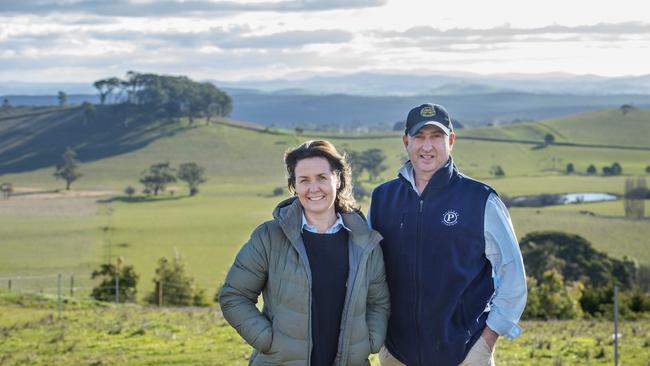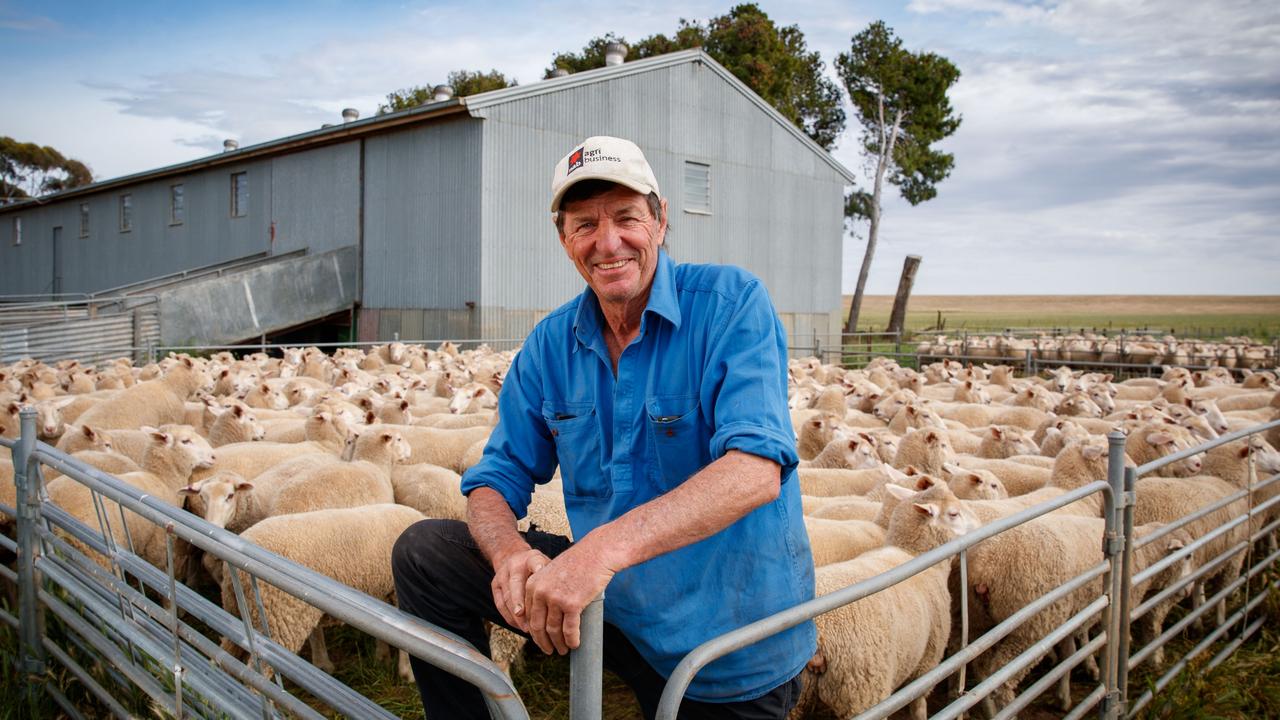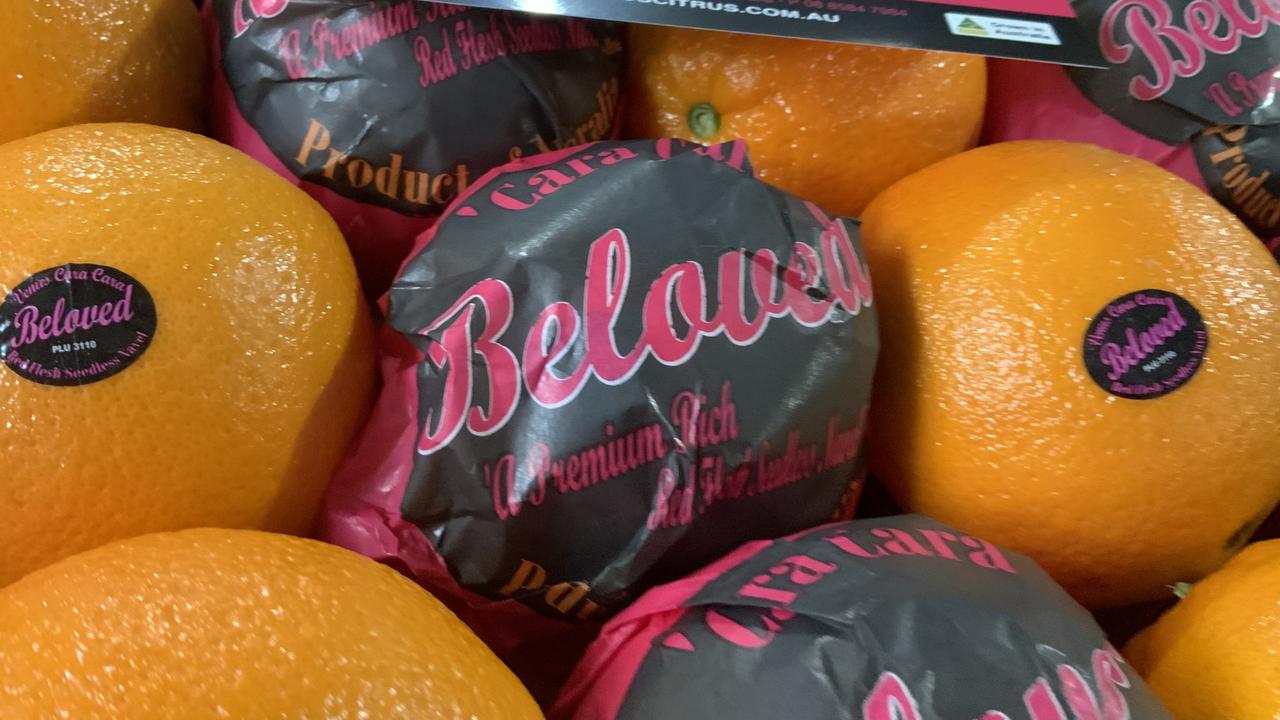Paringa Genetics takes scientific approach to beef farming
Tom and Olivia Lawson’s beef farming operation combines science with hybrid vigour in a colourful approach to advanced genetics.
TOM and Olivia Lawson’s approach to beef cattle breeding is anything but black-and-white.
In fact their quest to produce the most profitable and ethical product possible involves no shortage of colour — from the varying shades of their prized cattle to their red-hot passion for sustainable farming.
The Lawsons run Paringa Genetics, a diverse stud beef business running about 550 Red Angus, black Angus, Charolais and red and black composite Stabilizer cows at Murrindindi, in Victoria’s North East, and at Clarkes Hill, near Ballarat.
The operation, with science and hybrid vigour as its centrepieces, sells between 150 and 200 bulls a year to a growing client base seeking to produce born-to-perform calves that will return them a healthy premium.
Tom and Olivia, both agriculture science graduates, are passionate about beef production and the role data plays in “raising the steaks”, with their business tailored around meat quality, productivity, feed efficiency and reduced carbon emissions.
Unafraid to stretch the boundaries of industry tradition, they were the first to bring to Australia the four-way Stabilizer — “the idea being the more breeds, the more retained heterosis” — and are one of a handful of stud breeders in the nation linked to a worldwide multi-breed database developed to produce the most economically advanced genetics possible.
The Lawsons embraced biological farming practices about 20 years ago, long before it was considered sexy, turning their backs on the use of synthetic fertilisers and nitrogen, cutting back on chemicals and limiting cultivation in a bid to promote soil health.
In more recent years they have been involved with a Meat and Livestock Australia carbon-accounting project and the early stages of a farm biodiversity certification pilot scheme in which farmers are rewarded financially for their biodiversity and land stewardship.
“Climate variability will be the biggest challenge for our industry, without a doubt,” says Olivia, an independent Cattle Council of Australia director.
“It is how we can adapt and prepare for the impacts of that going forward. For beef producers it is going to be really important to have an adaptable and resilient cow herd.”
NUMBERS GAME
PARINGA was founded in 2006 as a Charolais stud and with a small commercial herd. The black and Red Angus and Stabilizer herds, made up of a 62 per cent Angus or Red Angus component, with South Devon, Simmental, Gelbvieh, Hereford, Shorthorn infusions, were added later.
Tom said the stud’s biggest challenge was the family’s relatively small land holding. At Murrindindi, the Lawsons own about 120ha and lease a further 325ha. At Clarkes Hill they have about 58ha to grow high-quality fodder or finish cattle.
To counter a lack of land, the couple run about 300 of their own cows and have an arrangement with two local co-operator herds to breed bulls for them. In total, there are about 550 cows under the Paringa “umbrella”.
The breeding program is designed by Tom and kicks off with artificial insemination in the second week of October for a calving that begins at the start of August.
Females receive two rounds of artificial insemination, with any that do not get in calf that way generally culled.
When it comes to making selections, the Lawsons focus on traits for calving ease, fertility, carcass, growth, docility and structure.
For the past 15 years they have been guided by the multi-breed $Profit system, developed by Canada’s Guelph University, which they said offered a “true economic spreadsheet” for genetic selection.
The system, which focuses on the three major intake measurements of feed efficiency, fertility and growth, offers an index on estimated price premiums a sire or dam might produce per 100 calves. The average is +$6000 (or a $60 premium per calf) with the top bulls achieving +$20,000.
There are about 1.5 million cattle worldwide recorded through $Profit, including from the US, UK, New Zealand and four herds in Australia.
Paringa has recorded all its sires on the system for the past five years.
“There is a lot of science behind it, it is very complex but it makes complete sense and has been proven to work,” Olivia said.

GLOBAL POSITIONING
THE Lawsons say while all their cattle are also recorded on Breedplan, $Profit enabled them to concentrate solely on profit-driven traits across all of their herds.
“It means you can compare them more easily than when you’ve got your purebred Charolais, purebred Red Angus and pure Black Angus all on Breedplan but recorded separately,” Olivia said.
“It’s also about comparing your cattle against some of the best in the world, not just your little pocket of the world.”
Tom said the system was “pretty exciting” having also eliminated some unwanted traits that came with certain selection pressures on Breedplan. For the past 15 years every sire entering the Paringa breeding program has had feed-efficiency data in-putted.
“Previously if we selected for growth of Breedplan, it took a lot of other traits in the wrong direction,” Tom said.
“Without that intake measurement in there, everything gets out of whack and that is why we are now seeing Angus cattle that are bigger than Charolais, because indirectly when you select for growth you select for more milk and the like.”
When the Lawsons weigh their cattle, they have the hip height measured and body condition scored, resulting in a surface-area prediction from which feed requirements can be measured. “Everyone used to laugh about the old hip-height measurement, but actually that measurement as part of an index is pretty powerful,” Tom said. “The Northern Genomic project found that hip-height measurement within the index was also highly correlated to fertility and calving ease.”
GROUP METHODS
WHEN it comes to grazing, cattle are run in contemporary groups dictated by age due to the need for data collection.
Tom said meant “we can’t pile everything in together as much as we’d like to” to optimise grazing pressure.
Mature-age cows are running in a mob of about 250 with 100 heifers.
“Two mobs for me is too many because I like that grazing pressure of hitting that pasture for the right amount of time and then letting it rest longer,” Tom said.
About a third of the Lawsons’ land is devoted to pasture cropping, a third to a perennial-type pasture system for cows and the remaining third comprising timber country with native grasses. Murrindindi receives about 625mm of a rain a year and Clarkes Hill about 800mm.
Tom and Olivia try and avoid supplementary feeding at all costs to graze year round while maintaining 100 per cent ground cover. They aim to have six months of feed ahead of their mobs. Paddock sizes vary from 2ha to 20ha and hot-wires have been used to split up paddocks.
“If you maintain your ground cover through late summer and into autumn, when it gets really tough, it means that as soon as you get your first rain you get really good response. You don’t get weeds coming up, you don’t get wind and rain erosion so you get a much better bounce-back,” Tom said.
The Lawsons, who received a Victorian sustainable farming award in 2014, became involved in biological farming through forums run by their local Landcare group. “The science really interested us,” Olivia said.
In the past they have used natural fertilisers, including blends of rockdust and lime, and live-bug mixes of microbes with Tom adding that “the best agent is cow shit”.
The couple are also passionate about animal welfare, with the likes of low-stress stockhandling methods used on farm and commercial cattle sold through programs such as Greenham’s Never-Ever and Provenir.
NATIONAL LEADER
PARINGA conducts two on-property sales a year. A yearling bull sale is held during spring, while a combination of 18-month-old bulls and yearlings is offered at auction in autumn.
This year’s spring sale will be held on October 1 featuring a catalogue of 70 Black Angus and Black Stabilizer and 30 Red Angus and Red Stabilizer bulls. Paringa is one of the biggest sellers of yearling bulls in the nation.
Of the 150-200 bulls the stud sells a year, a third are contract bred. Most remain in Victoria, with orders from NSW, Tasmania, Queensland, South Australia and Western Australia. A few bulls go to central Australia “depending on the season up there”.
“Our Alice Springs customers are still in quite a bit of trouble with the drought and they generally take 20-40 a year,” said Tom, who has also worked on the genetics advisory committee for beef behemoth Australian Agricultural Company.
Tom said the key to the success of his clients was maintaining a simple system. While it was “so easy to get distracted by all the technology” he worked with them to “really focus on live calves born in the first four weeks”.
“We’ve had clients lift calving rates from 30 to 80 per cent and that is through a number of things, but hybrid vigour is a big factor in that,” he said.
“As a stud producer, the most powerful thing is generational turnover. We turn over our whole bull battery every year and we can do that now because of technology (such as genomics). Before, we would have to wait five years until the bull was proven.
“A lot of our clients have now taken to turning their bulls over every three years and that is really powerful for their breeding herd in terms of genetic progress.”
Adding not just colour to the industry but more black to its bottom line.
MORE
SAHIWAL BREED HAS TICK OF APPROVAL FROM RICHARDSON FAMILY



